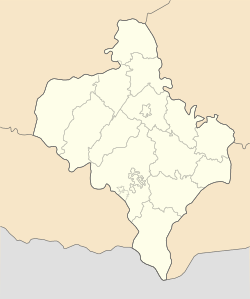Deliatyn
Deliatyn (Ukrainian: Делятин, Polish: Delatyn, Yiddish: דעלאטין) is an urban-type settlement in Nadvirna Raion (district) of Ivano-Frankivsk Oblast (region) of Ukraine. It is located 101 km west of Chernivtsi and 294.6 miles WSW of Kiev.[1] Together with Yaremche and Lanchyn it is part of a small agglomeration that runs along the Prut River valley between the Carpathian Mountains. Population: 8,430 (2016 est.)[2].
Deliatyn Делятин Delatyn | |
|---|---|
Urban-type settlement | |
.png) Coat of arms | |
 Deliatyn  Deliatyn | |
| Coordinates: 48°31′43″N 24°37′25″E | |
| Country | |
| Oblast (province) | |
| Raion (district) | Nadvirna |
| Founded | 1400 |
| Population | |
| • Total | 8,399 |
Name
Deliatyn is also known as Delatin, Delatyn (German), Deliatin (Hungarian), Delyatyn, and Delyatin.
History
Deliatyn became part of Poland (together with Red Ruthenia) in the 15th century. In 1772, it was seized by the Austro-Hungarian Empire together with the province of Galicia (see: Partitions of Poland). After World War I, the town was in the Second Polish Republic, in the Stanisławów Voivodeship. Located in the picturesque area, it was a popular spa, with around 1000 visitors yearly (in the late 1920s). Delatyn was captured by the Red Army in 1939 (see: Polish September Campaign).
After World War II, it was in the USSR; today it is in Ukraine.[1] During the Soviet times Deliatyn was famous by the Kovpak's Oak which symbolizes the uncompromised hatred of Ukrainians towards Nazi Germany. Delatyn was home to a Jewish community until the fall of 1941.[1]
According to the German archives, there were a few mass executions of Jews in the town, carried out by an Einsatzgruppen. On 16 October 1941, the Security police shot 1,950 Jews. Later around 200 Jews were killed in the cemetery. During spring 1942, 3,000 Jews were shot. The remaining 2,000 Jews were deported from Delyatyn to the Extermination camp Bełzec at the end of 1942. According to the archives, there was no ghetto in Delyatyn, although according to a witness there was one in the center, surrounded with a fence.[3]
Documentary film
The 1992 documentary film Return to My Shtetl Delatyn depicts filmmaker Willy Lindwer's travels with his father Berl Nuchim and his daughter Michal to Delatyn to "retrace the route his father had taken six decades earlier, escaping from the Nazis and to see how the area and its inhabitants had changed."[4]
Trivia
Delatynite is a variety of amber found in Deliatyn.[5][6]
References
- Shtetl Delatyn
- "Чисельність наявного населення України (Actual population of Ukraine)" (PDF) (in Ukrainian). State Statistics Service of Ukraine. Retrieved 19 July 2016.
- http://yahadmap.org/#village/delyatyn-deliatin-deliatyn-delatyn-ivano-frankivsk-ukraine.637
- The Willy Lindwer Film & Video Collection – Return to my Shtetl Delatyn
- "Chronology of Delatyn, Galicia". Archived from the original on 30 December 2006. Retrieved 14 April 2007.
- GemRocks: Amber